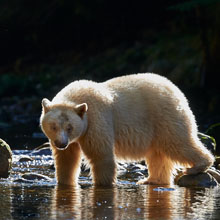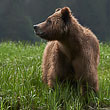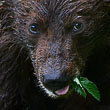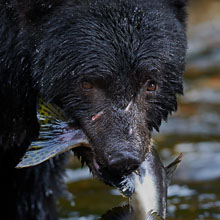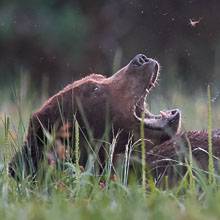Availability: Undetermined - Enquiries?
In the Field
This One's Mine? Great Bear Rainforest (central BC coast), BC, Canada. September 28, 2009.
Another example of what I think of as an "active portrait" - tightly framed wildlife shots where the subject is doing something (other than JUST looking at me or into the distance) and where I'm trying to capture a bit of the "essence" or personality of the subject. Judging by the scars on it's snout, this smallish black bear has had a bit of a rough go fitting in with his "pals" and when he approached me closely, snagged a salmon right from just in front of me, and then looked me in the eye, it was almost like he was saying "Please let me keep this one!" Anthropomorphic? Probably - but, inadvertent or not, he was definitely communicating something to me!
It's natural for young bears to have a challenge surviving their first few years after weaning - they get pushed around a LOT by their older brethren. Unfortunately, mankind is unintentionally doing one hell of a job stacking the odds even further against these guys. The energy and nutrients of millions of spawning salmon power the rich ecosystem we call the Great Bear Rainforest. Without the salmon there would be far less biomass in the system, including far fewer bears. Between depleting the salmon stocks by overfishing and exposing wild salmon to heavy parasite loads as they migrate past fish farms we're already increasing the difficulties of the lives of all members of the Great Bear Rainforest. And now, on top of these first two threats to the salmon and the entire ecosystem, some short-term thinking humans are considering running oil tankers directly through the narrow and difficult-to-navigate channels and inlets that make up the heart of the Great Bear Rainforest. The potential for catastrophic and irreparable damage to this globally unique ecosystem is so high that even considering such a ludicrous scheme should be unthinkable! Fortunately, two very competent environmental groups are working around the clock to spread the word about this latest threat to the Great Bear Rainforest - and they both would benefit from your support. So...click thru to the website of the Raincoast Conservation Foundation to learn more and see what you can do to lend a hand. Thanks!
OK - rant over (for now) - back to the image. There were some challenges in capturing this image (including enduring bootfulls of very cold stream water!), but the bigger challenges were in processing the image. Between the whiter-than-white belly of salmon and the dark black-on-black tones of the bear this image pushed the limit of what my camera's sensor could capture. As always, I exposed to retain highlight details and left retrieval of the black-on-black detail to post-processing. I'm not a fan of the shadow/highlight tools of raw converters or image editing programs so I use a more time-consuming (but, I would argue, more precise and less prone to noise creation) exposure blending technique. It's similar to HIgh Dynamic Range (or HDR) processing, but instead of combining multiple exposures captured in the field (which is pretty impractical with wildlife photography), I combine multiple versions of a single converted raw file where each version differs in the exposure assigned to it. This image was one of the most complex I've ever blended and I ended up blending 5 exposure versions before (over a 2.5 stop range) before I got this one to suit my taste (and, I think, recreate what I saw through the viewfinder).
Anyway...good luck little bear - I hope you can find enough fish to sustain you over a long life...
NOTE: This image was captured in a region of British Columbia known as "The Great Bear Rainforest". I offer both instructional photo tours and "photo op only" photo tours into the Great Bear Rainforest each spring and autumn. If you're interested in more information, just check out the Photo Tours page of this website!
Behind the Camera
This One's Mine? Great Bear Rainforest (central BC coast), BC, Canada. September 28, 2009.
Digital Capture; RAW 14-bit format; ISO 220.
Nikon D3 with Nikkor 200mm f2 VR. Hand-held (VR on and in normal mode).
1/160s @ f2.8; -0.33 stop compensation from matrix-metered exposure setting.
At the Computer
This One's Mine? Great Bear Rainforest (central BC coast), BC, Canada. September 28, 2009.
RAW Conversion to 16-bit TIFF, including first-pass/capture sharpening using Phase One's Capture One Pro 6. Five raw conversions varying in exposure settings over a 2.5 stop range.
Further digital corrections on 16-bit TIFF file using Adobe's Photoshop CS5. Photoshop adjustments including blending of 5 exposure versions, selective exposure and tone curve adjustment, selective colour saturation and desaturation, and selective sharpening for web output.
Conservation
This One's Mine? Great Bear Rainforest (central BC coast), BC, Canada. September 28, 2009.
Ten percent of the revenue generated by this image will be donated to Raincoast*.
Species Status in Canada**: Not currently listed as Threatened or Endangered.
This black bear is a member of the subspecies "Kermodei" (Ursus americana kermodei). This subspecies is unique in that the population is characterized by having an unusually high proportion of a recessive gene that produces white coat colour (found on the "Spirit Bears"). Because the Black Bear is not considered under threat as a species, both the Kermodei subspecies and the very rare Spirit Bear suffer from having the same conservation designation (it should be acknowledged that in British Columbia - the jurisdiction of greatest Spirit Bear abundance - hunting of these white-coated bears is not permitted). For reasons that are not fully understood, the Spirit Bear occurs with greater frequency in a relatively small geographic area within The Great Bear Rainforest of the central and northern coast of British Columbia. In this area 10 to 30% of the bears possess white coats. Many of the black-coloured Black Bears in this region carry the gene for white coats, so allowing hunting of ANY Black Bears in this region can reduce the frequency of the gene for white coats. Thus, to protect the Spirit Bear, it is necessary to prohibit the hunting of ALL Black Bears in this region. And, very unfortunately, the globally unique ecosystem that contains the Spirit Bear is under development pressure, especially from the forestry industry. If this unique environment is altered, we may lose the wonderful genetic anomaly known as the Spirit Bear forever.
*The Raincoast Conservation Society (and Foundation) is an effective and efficient organization that has been fighting for protection of this unique habitat. If you are looking for a meaningful way to contribute to the conservation of this amazing ecosystem, Raincoast will provide maximal "bang" for your conservation dollars.
**as determined by COSEWIC: The Committee on the Status of Endangered Wildlife in Canada



















